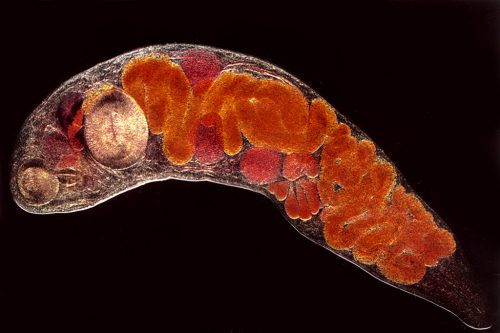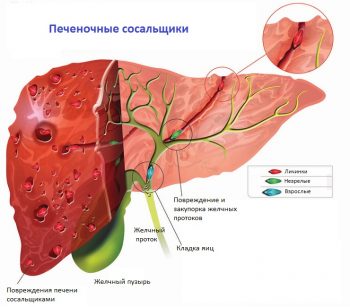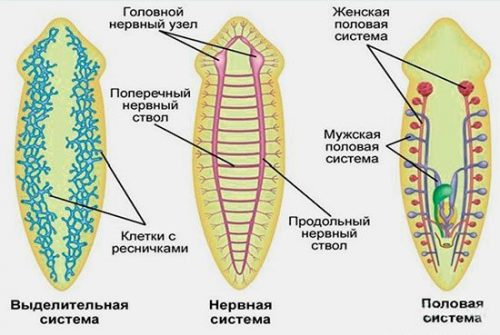They are classified as follows:
The last subclass includes the largest number of flatworm fluke species. These trematodes live in organisms of molluscs (intermediate host) and vertebrates (definitive host).
Anatomy
The body shape of the trematode is flattened oval or worm-shaped. As a rule, the worm does not exceed a length of several centimeters. Among them there are absolutely crumbs, for example, a carp fluke, which is no more than 0.5 mm long. Other worms can reach 7 centimeters (giant fluke).

A common characteristic of flukes is the presence of two suckers, one located closer to the mouth, and the other on the underside of the worm. These structural features help them to gain a foothold in the host body. The flukes have very developed muscles, it helps them move through the host's body. The muscles in the pharynx facilitate feeding.
The body of trematodes is covered with a dense rigid tegument. This shell protects against the digestive enzymes of flukes, whose habitat is the intestines of large animals and humans. The tegument also has a respiratory function, that is, gas exchange is carried out through it. This is due to the fact that the structure of the fluke does not provide for other organs that help him breathe.
The structure of the digestive, excretory and nervous systems
The mouth is located at the anterior end of the helminth or closer to the abdominal surface. The digestive system of flukes continues with a muscular pharynx, which performs pumping movements. Through a short esophagus, it connects to one or two caecum, which occupy most of the length of the body. In some species they are simple, while in others they are branched. Like tapeworms, flukes do not have an anus and waste material is expelled through the mouth opening.

The excretion of nitrogenous waste occurs mainly through the tegument. This is carried out in the process of gas exchange (respiration). The excretory system of flukes is mainly associated with osmoregulation. It consists of two or more protonephridia (analogous to the kidneys) that exit into the collecting ducts on each side of the body. They usually occur in the same bladder, forming a ring system.
reproductive organs
Reproduction in most trematodes is asexual. Representatives of flukes are hermaphrodites, having male and female organs. Thus, they can be cross fertilized or independently. The exception is schistosomes - they are dioecious.
The reproductive system of flukes (male) includes two testes. Their location varies among species. From them come the seminal ducts, which connect to each other on the underside of the anterior half of the worm. This final part of the male system differs in structure between species, and may include sperm sacs and accessory glands. Some worms have a copulatory organ, which may be called a cirrus (if it everts) or a penis (if it doesn't).

The ootype connects to the elongated uterus. It exits into the genital pore, next to the male orifice. In most flukes, sperm cells travel through the uterus to reach the ootype, where fertilization occurs. This is how the reproduction of flukes proceeds.
Fertilized eggs are excreted along with feces from the host's body. The goal is not to overpopulate it, as increasing their numbers will hasten the death of the host, and with it the adults who can continue to breed will die.
After the eggs are released into the environment, larvae emerge from them over time. To do this, they require certain conditions - most often heat and humidity. Almost all trematodes infect mollusks. They become their first owners. In their body, the development of the fluke, which has already become a larva, continues.
At the right time, they leave it to find an intermediate or already final host. During their lives, trematodes go through a variety of forms. For example, the cycle of development and change of owners of a fluke can be as follows:
- The trematodes emerge from the definitive host as eggs that are mature enough to withstand harsh environmental conditions.
- A miracidium emerges from the egg. It infects the first intermediate host by active or passive transmission.
- Inside the first intermediate host - the snail - sporocysts are formed, which begin to feed by diffusion through the tegument.
- Redia can also form inside the snail. A developed pharynx helps them in nutrition. Redia or sporocysts develop into cercaria through polyembryony.
- Cercariae can spread in space and are distinguished by a variety of morphology. They are adapted to recognize the next host and penetrate into its body, have behavioral and physiological means of adaptation that are not present in the early stages of life.
- Metacercariae is an adapted cystic form that is dormant in the secondary intermediate host.
- The adult worm is the fully developed form that infects the final host.
infections
Trematodes cause a wide variety of ailments in humans. The most common infections are in Asia, Africa, Latin and South America and the Middle East. This is due to the fact that in these regions, as a rule, the conditions for the development of helminths are the most favorable.
In addition, flukes are found wherever people use their feces as fertilizer without pre-treatment.Representatives of flukes can be divided into groups depending on the organ where they live:
Treatment is carried out with extreme caution in young children, expectant and breastfeeding mothers. This anthelmintic drug is toxic and its safety in these patient populations has not been established.
If the trematodosis is complicated by concomitant bacterial infections, the doctor may prescribe an antibiotic drug. For lesions of the nervous system, as occurs with neuroschistosomiasis, steroids are recommended. Anemia is treated with iron supplements.
In advanced cases, surgical treatment is most often required. For example, surgery is necessary for the following complications of infections caused by flukes:
- Bladder carcinoma that develops with urogenital schistosomiasis.
- Fibrosis and thickening of the intestinal wall in intestinal schistosomiasis.
- Ascending cholangitis in fascioliasis.
- Cholangiogenic cancer due to clonorchiasis.
Can they be prevented?
Prevention of trematodosis includes simple measures aimed at improving personal hygiene. Handwashing, careful handling and preparation of fish, aquatic vegetables, fruits and other plant foods are all essential to avoid ingesting infectious forms of flukes.
Flukes are diverse and almost ubiquitous. Many of them pose a serious danger, as they cause serious illnesses, the symptoms of which at first can be confused with ordinary indigestion or poisoning. To avoid infection and the need for treatment, you need to be attentive to your health and follow the rules of hygiene at home and when traveling.



